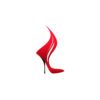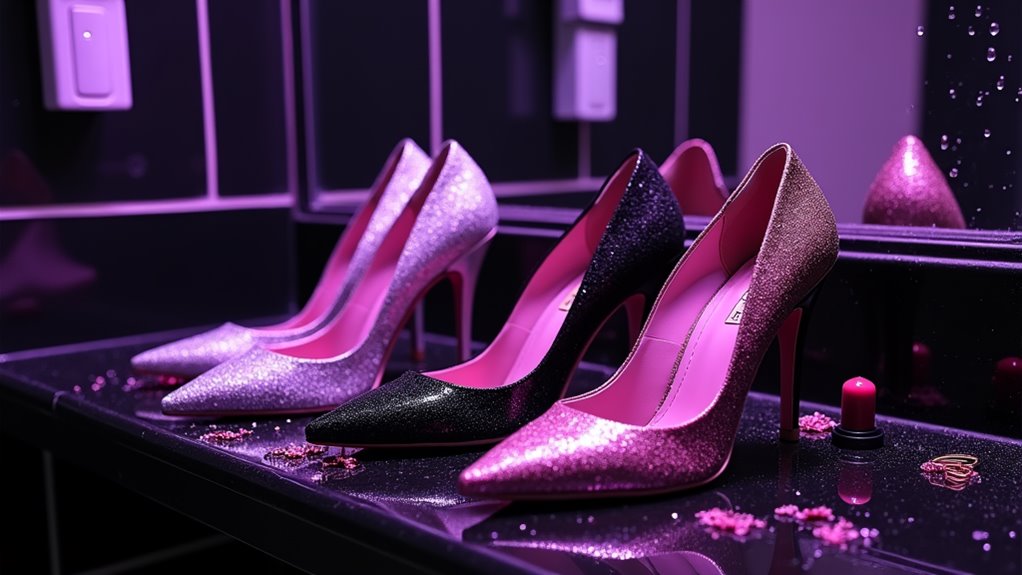There may be products. Products are independently selected by our editors. We may earn an affiliate commission from the links with no charge to you, example: as Amazon Affiliate.
We’re seeing heels take on new meaning in today’s club culture, where they’re more than just footwear – they’re powerful status symbols that shape our nightlife experience. While high heels traditionally signal glamour and confidence on the dance floor, younger generations are challenging these expectations by prioritizing comfort alongside style. The rhythmic click of heels still contributes to club ambiance and social dynamics, but modern trends embrace diverse choices from stilettos to stylish flats. As club fashion evolves, the interplay between traditional heel-wearing and comfort-focused options reveals deeper shifts in how we express ourselves after dark.
Key Takeaways
- High heels remain an unofficial dress code in nightlife venues, influencing door policies and establishing social status within club culture.
- Wearing heels provides psychological benefits like increased confidence and assertiveness, enhancing social interactions in club settings.
- The rhythmic sound of heels contributes to nightclub ambiance while serving as a tool for self-expression and non-verbal communication.
- Modern club culture shows a shift toward comfort-focused footwear choices, especially among younger generations challenging traditional fashion norms.
- Health concerns and comfort considerations are driving innovations in heel design, incorporating padded insoles and more ergonomic features.
The Cultural Weight of Heels
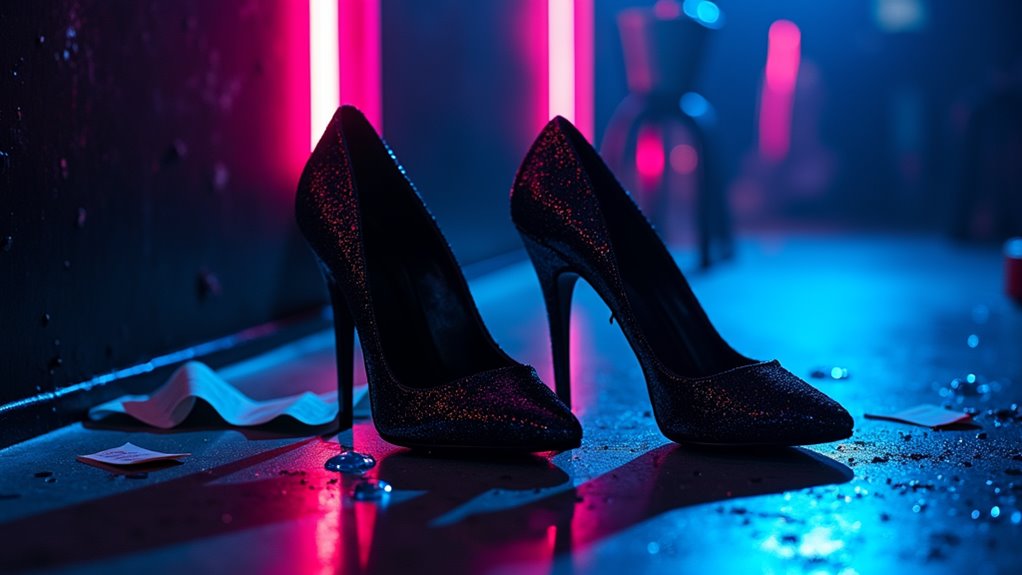
While high heels have walked through centuries of fashion history, they’ve carved out a particularly potent niche in modern clubbing culture. In today’s nightlife scene, we’re witnessing how these elevated shoes have become more than just fashionable footwear – they’re powerful cultural symbols that shape social interactions and personal identity on the dance floor.
When we look at club culture today, we can’t ignore how wearing heels has become intertwined with notions of status and desirability. They’ve become unofficial dress code requirements at many venues, reflecting deeper societal expectations about luxury and exclusivity. We’re seeing how this seemingly simple choice of footwear influences everything from door policies to patron spending patterns.
Yet, we’re also noticing a shift in the conversation. As younger generations enter nightlife spaces, they’re challenging these long-held assumptions about heels and femininity. What was once an unquestioned element of a night out has become the center of important discussions about autonomy and gender expectations. We’re watching club culture evolve as comfort increasingly competes with convention, suggesting that the cultural weight of heels might be lifting for future generations.
Just as essential music tools shape the soundscapes of nightclub environments, heels continue to influence the visual and social dynamics of these spaces.
Social Power on Dance Floors
We’ve all witnessed how heels transform the dance floor into a social power arena, where added height instantly commands attention and shifts the dynamics of interaction. Those extra inches aren’t just about physical elevation – they’re strategic tools that help us navigate crowded spaces and establish our presence with authority. When we’re moving through the club in heels, we’re not just dancing; we’re wielding a form of social capital that makes us more visible, more approachable, and more influential in the nightlife ecosystem. While club-goers often prioritize style over practicality, many dancers opt for professional heel styles that provide both elegance and comfort during long nights out.
Height Advantage Dynamics
In the dynamic landscape of nightclub culture, the strategic advantage of added height from heels transforms more than just physical stature – it’s a powerful tool for commanding social presence on the dance floor. When we’re going to the club, the decision to wear heels isn’t just about fashion; it’s about leveraging height advantage to maximize our social impact and visibility.
We’ve observed how the elevated positioning creates an immediate shift in social dynamics. The added inches don’t just elongate our silhouette; they create an auditory presence with each step, making us impossible to ignore in crowded spaces. This heightened visibility translates into enhanced confidence and improved posture, naturally drawing attention and facilitating more engaging social interactions.
The cultural significance of heels in nightlife settings can’t be understated. We’re tapping into deeply ingrained social cues that associate elevated stature with status and desirability. When navigating the bustling dance floor, this height advantage becomes particularly powerful, enabling clearer non-verbal communication and creating natural opportunities for flirtation and social connection. It’s a subtle yet effective way to stand out and command attention in the competitive nightclub environment.
Dance Floor Command
Every aspect of dance floor dynamics shifts when heels enter the equation, transforming ordinary movements into powerful statements of social dominance. We’ve seen how these elevated shoes command attention in the club scene, where the distinct click-clack rhythm adds a percussive element to the music and draws eyes to the wearer.
When we dress for the club, heels aren’t just accessories – they’re power tools that heighten our physical and psychological presence. In the bustling atmosphere, they give us that extra edge, making us feel more confident and approachable. It’s fascinating how this simple change in footwear can completely alter the social landscape of a dance floor.
We’re witnessing a cultural phenomenon where heels have become more than just fashion statements – they’re catalysts for social interaction. They create an immediate visual impact, helping us stand out in crowded spaces and signaling our readiness to engage. The way we move in heels sends clear messages about confidence and social availability, making them essential players in the subtle art of nightlife navigation. They’ve become integral to the modern club experience, shaping how we’re perceived and how we interact.
Fashion Meets Function
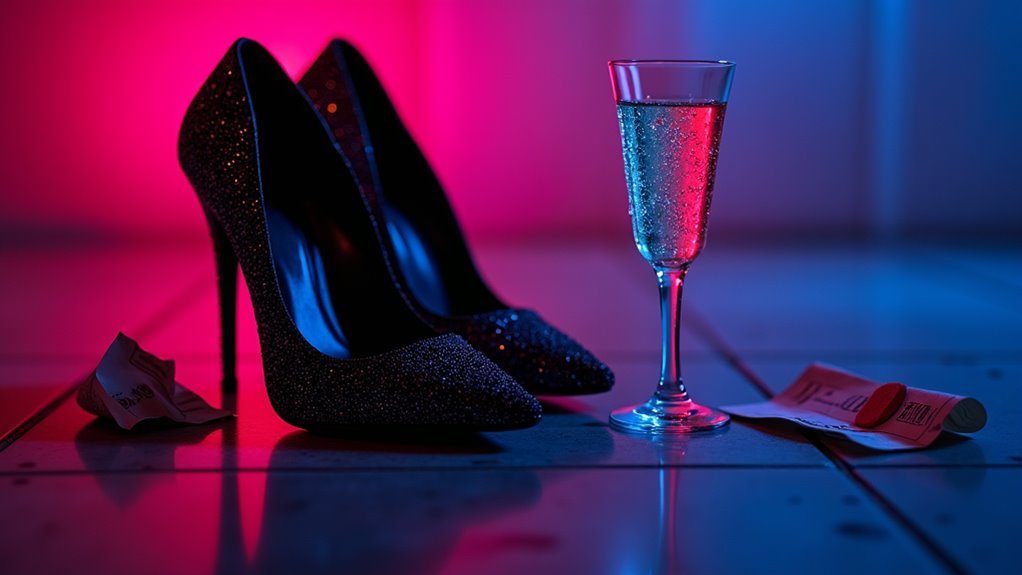
We’re witnessing a radical shift in club footwear as fashionistas embrace designs that merge killer looks with actual wearability. Today’s savviest clubgoers opt for block heels, cushioned platforms, and even stylish low-heeled options that keep them dancing past midnight without sacrificing the elevated silhouette that heels provide. Modern shoe designers have caught on, creating collections that cater to this demand for functional glamour, with features like padded insoles and stable constructions that work as hard on the dance floor as they do in Instagram photos. Finding the perfect pair of comfortable formal heels can transform your nightlife experience from painful to pleasurable.
Style Versus Comfort Balance
The delicate balance between style and comfort has become a defining challenge in modern clubbing culture, where the iconic status of high heels clashes with evolving attitudes about practicality. We’re witnessing a generational shift in priorities, as millennials who once endured nights of discomfort in towering stilettos now watch younger clubbers prioritize function over fashion.
While wearing heels continues to symbolize confidence and glamour on the dance floor, we can’t ignore the growing recognition of their physical toll. Today’s club scene reflects this tension, with many of us carrying backup flats or seeking out versatile footwear options that don’t sacrifice style for comfort. The traditional image of switching from heels to flats mid-evening has become a familiar sight in club bathrooms and street corners.
What’s emerging is a more nuanced approach to style versus comfort in clubbing culture. Fashion innovators are responding with designs that bridge the gap, creating footwear that works seamlessly from day to night. We’re moving toward a future where the choice between looking fabulous and feeling comfortable isn’t an either-or proposition.
Dance Floor Ready Designs
Modern club fashion has evolved to embrace innovative designs that perfectly balance form and function on the dance floor. We’re seeing a surge in platform stilettos and peep-toe boots that don’t just elevate height but create an unmistakable fashion statement in nightlife settings. These designs are thoughtfully curated to complement the latest clubbing trends while ensuring wearers can move confidently through the night.
What’s particularly striking is how today’s heels are engineered for the club environment. We’re noticing a shift toward designs that merge sophistication with practicality, offering mid-heel options that let us dance for hours while maintaining that essential glamorous edge. The way these heels interact with carefully chosen outfits creates powerful visual impact, allowing for individual expression that stands out in the crowd.
On the dance floor, these designs serve a dual purpose. They’re not just about looking fabulous – they’re about feeling empowered. We’re witnessing how strategic heel choices enhance social confidence, enabling natural movement and self-expression while maintaining that perfect balance of style and stability that modern clubbing demands.
Beyond Style and Status
While fashion choices often reflect surface-level style and status, heels in nightclub culture transcend mere aesthetic appeal to become powerful tools of self-expression and social dynamics. We’re witnessing how heels can lead to enhanced social presence, creating memorable interactions that shape our nightlife experiences. In a world where dress codes and cultural expectations intersect, these shoes serve as catalysts for confidence and self-assurance.
Beyond their visual impact, heels function as social signals that influence how we navigate nightclub environments. We’re seeing a fascinating interplay between personal autonomy and societal expectations, where the choice to wear heels reflects deeper considerations about identity and social positioning. They’re not just accessories but conversation starters, mood enhancers, and confidence boosters that transform how we engage with others in these spaces.
The ongoing dialogue about heels in nightclub culture reveals complex layers of social interaction and personal empowerment. We’re noticing how they shape both the wearer’s self-perception and others’ responses, creating a dynamic interplay that goes far beyond fashion statements to influence the entire social fabric of nightlife environments. For those seeking enduring style, timeless black leather heels remain a quintessential choice for any nightlife occasion.
Health Impacts and Considerations
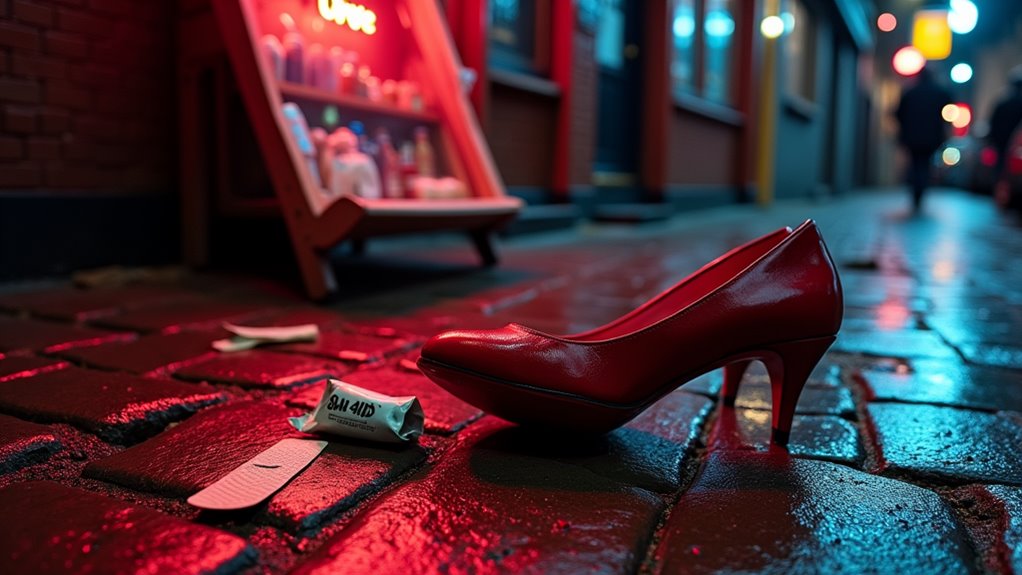
High heels’ impact on our physical well-being has become an increasingly serious consideration in nightclub culture, where we’re seeing a growing awareness of health risks associated with these fashion staples. The evidence is mounting: regular high heel wear can lead to plantar fasciitis, a painful condition affecting the heel and arch of the foot, disrupting natural weight distribution and compromising essential support.
We’re noticing a shift in how clubgoers approach their footwear choices, as more of us become aware of the potential health impacts. From forefoot injuries to stress fractures, the list of medical concerns linked to frequent heel-wearing is substantial. Those who’ve spent years dancing in stilettos are now sharing their stories of developing bunions and experiencing chronic ankle problems, serving as cautionary tales for younger generations.
Today’s podiatrists are clear: prioritizing proper foot support isn’t just about comfort – it’s about preventing long-term damage. We’re seeing this wisdom reflected in evolving club fashion, where many are opting for more foot-friendly alternatives that don’t sacrifice style for health, especially as we consider the cumulative effects of our nightlife choices. Fortunately, modern premium comfort heels offer innovative solutions that balance style with foot health.
Generational Shifts in Club Wear
Evolution in club culture reveals a striking generational divide when it comes to footwear choices. We’re witnessing a notable shift away from the stiletto-dominated scene of 2008-2014, as Gen Z club-goers increasingly opt for comfort over traditional style expectations. This transformation isn’t just about personal preference – it’s reshaping the very essence of nightlife dress codes.
A viral TikTok video by Rachel Parrish, which captured nearly 21 million views, perfectly encapsulates this cultural conversation. The heated debate in the comments section demonstrates how deeply this shift has affected club culture, with traditionalists defending heels as an essential element of nightlife glamour while younger party-goers champion practical footwear choices. We’re seeing a clear pattern emerge where comfort-focused options like sneakers and flats are becoming the new norm.
This transition signifies more than just a change in footwear preferences – it’s a broader statement about evolving social expectations. Today’s younger generation is actively challenging the conventional wisdom that heels are a necessary component of club attire, prioritizing their ability to dance and move freely throughout the night. The growing demand for party comfort shoes has sparked a whole new category in nightlife footwear design.
Psychology of Height Enhancement
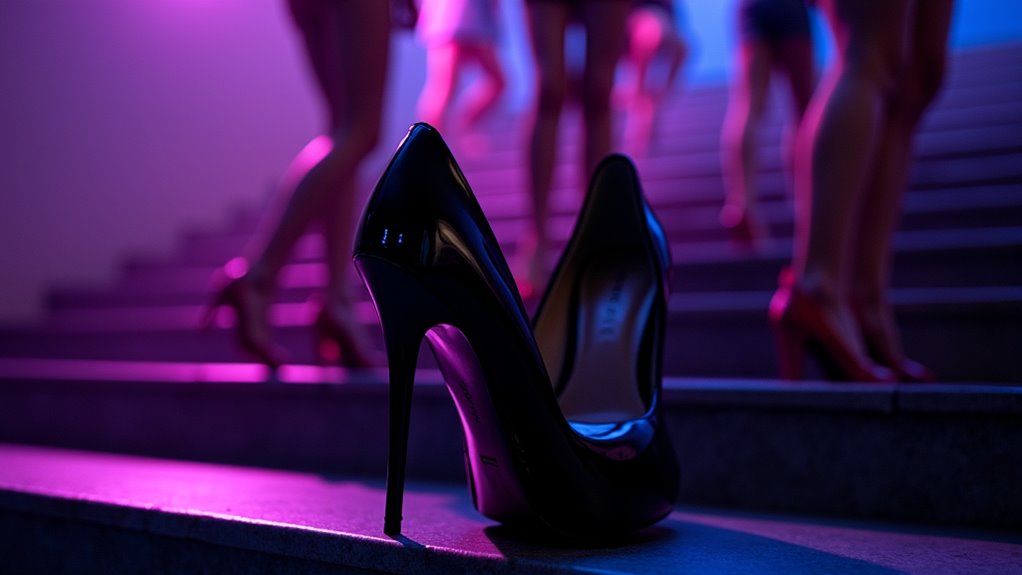
Beyond the comfort-versus-style debate, the psychology behind wearing heels in clubs runs deeper than mere fashion choices. We’ve all heard the familiar refrain “heels make me feel powerful,” and there’s scientific backing to this sentiment. The immediate height boost affects both our physical presence and mental state, creating a domino effect of confidence that ripples through our social interactions.
When we’re elevated in a crowded club setting, we’re not just physically taller – we’re experiencing a psychological uplift that transforms how we carry ourselves. The clicking sound of heels on the dance floor becomes our personal soundtrack, commanding attention and marking our presence in the space. This auditory element, combined with increased visibility, makes us more approachable and socially magnetic.
We’ve noticed how this height enhancement plays into natural social dynamics, especially in flirtatious encounters. It’s not just about being seen above the crowd; it’s about the self-assurance that comes with enhanced posture and presence. This boost in confidence often translates into more meaningful social connections and a more memorable night out. Modern comfort-focused designs have revolutionized how we approach heel-wearing during extended nights of dancing and socializing.
Navigating Social Expectations
While nightclub dress codes have evolved over decades, strict expectations about heels persist as unwritten rules that shape our social landscape. We’re witnessing a fascinating tension between traditional societal expectations and modern comfort preferences, particularly when it comes to heels to the club. Many venues still subtly teach the girls these unspoken rules through selective entry policies and social pressure.
- Elevated status symbols remain deeply embedded in nightlife culture
- The choice between comfort and conformity creates real social anxiety
- Younger clubbers increasingly challenge traditional dress norms
- Venue policies often tacitly enforce heel-wearing through subtle discrimination
As we navigate these expectations, we’re seeing a gradual shift in how people approach club fashion. While heels continue to symbolize sophistication and desirability in nightlife settings, there’s growing resistance to these rigid standards. We’re noticing more venues adapting their policies to accommodate diverse footwear choices, though the underlying pressure to conform remains strong. This evolution reflects broader conversations about gender norms and personal autonomy in social spaces, challenging us to reconsider what “appropriate” club attire really means. Some clubgoers are incorporating royal gem designs into their heel accessories to add an extra touch of glamour to their nighttime looks.
Modern Club Fashion Evolution
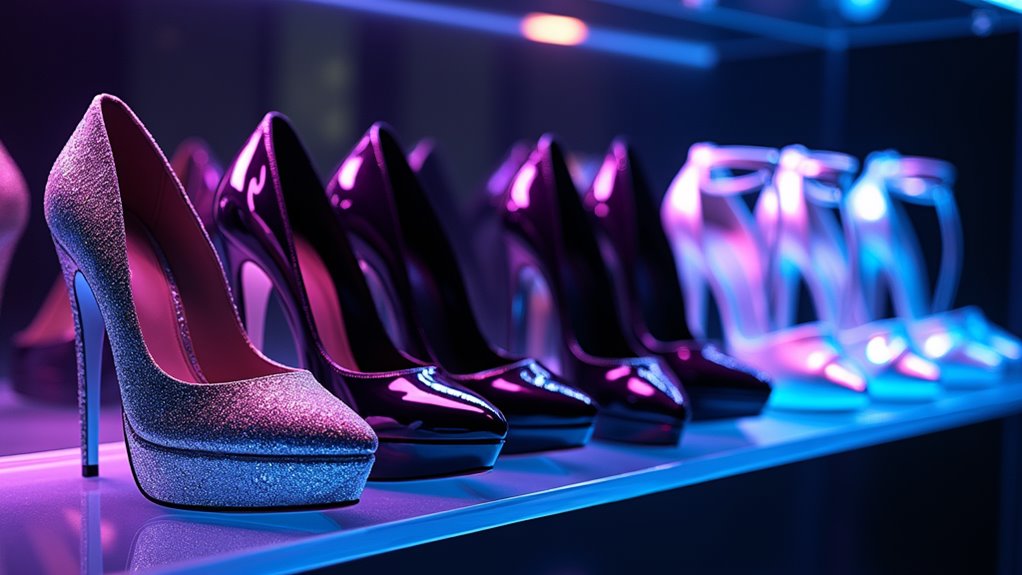
Countless fashion shifts have reshaped club culture since the heel-dominant era of 2008-2014, marking a dramatic transformation in nightlife footwear preferences. We’re witnessing modern club fashion evolve as comfort-focused choices challenge traditional style norms, with sneakers and flats gaining significant ground in venues where stilettos once reigned supreme. Today’s environmentally conscious clubgoers are increasingly choosing eco-friendly non-leather heels as sustainable alternatives to traditional footwear.
| Era | Fashion Trends | Footwear Priority | Cultural Impact |
|---|---|---|---|
| 2008-2014 | High Heel Dominant | Style First | Status Symbol |
| 2015-2018 | Mixed Choices | Style & Comfort | Transitional Period |
| 2019-2021 | Comfort Rise | Practical Wear | Social Media Influence |
| 2022-Present | Diverse Options | Personal Choice | Individual Expression |
While evolving footwear trends point toward comfort-first approaches, we can’t ignore the nostalgic pull of heel culture back into the nightlife scene. Today’s club-goers navigate between practical comfort and the timeless allure of heels, creating a dynamic where both choices coexist. This shift reflects broader changes in how we view nightlife fashion, with younger generations leading the charge in redefining what constitutes appropriate club attire.
Conclusion
While we’ll always see heels commanding space on dance floors, we’re witnessing a cultural shift where comfort’s taking the lead. Sure, some might argue that flat shoes sacrifice glamour, but today’s clubgoers are rewriting the rules with statement sneakers and embellished flats that pack just as much punch. We’re moving beyond the notion that suffering equals style, embracing a fresh era where we can dance all night without the morning-after regrets.
